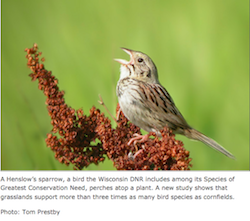A new research paper examines the relationship between bioenergy and the birds. The study, conducted by researchers at the University of Wisconsin-Madison (UW-Madison) in conjunction with the Wisconsin Department of Natural Resources (DNR) and published in PLOS ONE, looked at whether corn and perennial grassland fields in southern Wisconsin could provide both biomass for bioenergy as well as a bird habitat.
The answer is yes.
 The study found that where there are grasslands there are birds. For example, grass and wildflower dominated field supported more than three times as many bird species as cornfields. And grassland fields can product ample biomass to be used to produce advanced biofuels.
The study found that where there are grasslands there are birds. For example, grass and wildflower dominated field supported more than three times as many bird species as cornfields. And grassland fields can product ample biomass to be used to produce advanced biofuels.
Monica Turner, UW-Madison professor of zoology, and study lead author Peter Blank, a postdoctoral researcher in her lab, hope the findings help drive decisions that benefit both birds and biofuels, too, by providing information for land managers, farmers, conservationists and policy makers as the bioenergy industry ramps up, particularly in Wisconsin and the central U.S.
The research team selected 30 different grassland sites – three of which are already used for small-scale bioenergy production – and 11 cornfields in southern Wisconsin. Over the course of two years, the researchers characterized the vegetation growing in each field, calculated and estimated the biomass yields possible, and counted the total numbers of birds and bird species observed in them.
According to Blank and Turner, the study is one of the first to examine grassland fields already producing biomass for biofuels and is one of only a few analyses to examine the impact of bioenergy production on birds. While previous studies suggest corn is a more profitable biofuel crop than grasses and other types of vegetation, the new findings indicate grassland fields may represent an acceptable tradeoff between creating biomass for bioenergy and providing habitat for grassland birds. The landscape could benefit other species, too.
Among the grasslands studied, the team found monoculture grasses supported fewer birds and fewer bird species than grasslands with a mix of grass types and other kinds of vegetation, like wildflowers. The team found that the presence of grasslands within one kilometer of the study sites also helped boost bird species diversity and bird density in the area.
This is an opportunity, Turner said, to inform large-scale land use planning. By locating biomass-producing fields near existing grasslands, both birds and the biofuels industry can win.

